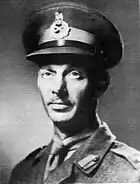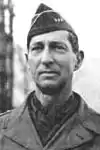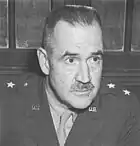Allied invasion of Italy order of battle
The Allied invasion of Italy, a phase of the Mediterranean Theater of World War II, took place on 3 September at Reggio di Calabria (Operation Baytown), and on 9 September 1943 at Taranto and Salerno (Operations Slapstick and Avalanche respectively). Allied naval forces landed American and Commonwealth troops on the beaches of southern Italy where they faced resistance from Axis forces.

Forces and paths for the Allied invasion of Italy
Allied Forces
Theatre and army group commanders

Gen. Dwight D. Eisenhower

Fld. Mrshl. Sir Harold Alexander
Allied Forces Headquarters (AFHQ), Mediterranean
General Dwight D. Eisenhower
- Allied Naval Forces, Mediterranean (Admiral Andrew Cunningham)
- Western Task Force (Operation Avalanche) (Vice Admiral H. Kent Hewitt, USN)
- Force H (Vice Admiral Sir Algernon Willis, RN)
- Naval Task Force, Operation Slapstick (Vice Admiral Arthur Power, RN)
- Mediterranean Air Command (Allied) (Air Chief Marshal Sir Arthur Tedder)[lower-alpha 1]
Allied 15th Army Group
General Sir Harold Alexander
Operation Baytown – 3 September
Landings across Strait of Messina
British Eighth Army
Eighth Army and XIII Corps commanders

Gen. Sir Bernard L. Montgomery

Lt.-Gen. Sir Miles Dempsey
- General Sir Bernard Law Montgomery
British XIII Corps
- Lieutenant-General Sir Miles Dempsey
- British 5th Infantry Division[2] (Major-General Gerard Bucknall)
- 13th Infantry Brigade (Brigadier L.M. Campbell)
- 2nd Battalion Cameronians (Scottish Rifles)
- 2nd Battalion Royal Inniskilling Fusiliers
- 2nd Battalion Wiltshire Regiment
- 15th Infantry Brigade (Brigadier E.O. Martin)
- 1st Battalion Green Howards
- 1st Battalion King's Own Yorkshire Light Infantry
- 1st Battalion York and Lancaster Regiment
- 17th Infantry Brigade (Brigadier Dudley Ward)
- 2nd Battalion Royal Scots Fusiliers
- 2nd Battalion Northamptonshire Regiment
- 6th Battalion Seaforth Highlanders
- Divisional troops
- 7th Battalion, Cheshire Regiment (Machine Gun Battalion)
- 5th Reconnaissance Regiment, Reconnaissance Corps
- 91st (4th London) Field Regiment, Royal Artillery
- 92nd (5th London) Field Regiment, Royal Artillery
- 156th (Lanarkshire Yeomanry) Field Regiment, Royal Artillery
- 52nd (6th London) Anti-Tank Regiment, Royal Artillery
- 18th Light Anti-Aircraft Regiment, Royal Artillery
- 38th Field Company, Royal Engineers
- 245th Field Company, Royal Engineers
- 252nd Field Company, Royal Engineers
- 254th Field Park Company, Royal Engineers
- 13th Infantry Brigade (Brigadier L.M. Campbell)
- Canadian 1st Infantry Division[3] (Major-General Guy Simonds)
- Canadian 1st Infantry Brigade (Brigadier Howard Graham)
- The Royal Canadian Regiment
- 1st Battalion, The Hastings and Prince Edward Regiment
- 1st Battalion, 48th Highlanders of Canada
- Canadian 2nd Canadian Infantry Brigade (Brigadier Chris Vokes)
- Princess Patricia's Canadian Light Infantry
- 1st Battalion, The Seaforth Highlanders of Canada
- 1st Battalion, The Loyal Edmonton Regiment
- Canadian 3rd Infantry Brigade (Brigadier M.H.S. Penhale)
- Royal 22e Régiment
- 1st Battalion, The Carleton and York Regiment
- 1st Battalion, The West Nova Scotia Regiment
- Canadian 1st Armoured Brigade (Brigadier R.A. Wyman)
- Divisional troops
- 4th Reconnaissance Regiment (4th Princess Louise Dragoon Guards)
- 1st Infantry Division Support Battalion (The Saskatoon Light Infantry) (Machine Gun Battalion)
- 1st Field Regiment, Royal Canadian Horse Artillery
- 2nd Field Regiment, Royal Canadian Artillery
- 3rd Field Regiment, Royal Canadian Artillery
- 1st Anti-Tank Regiment, Royal Canadian Artillery
- 1st Light Anti-Aircraft Regiment, Royal Canadian Artillery
- 1st Field Company, Royal Canadian Engineers
- 3rd Field Company, Royal Canadian Engineers
- 4th Field Company, Royal Canadian Engineers
- 2nd Field Park Company, Royal Canadian Engineers
- Canadian 1st Infantry Brigade (Brigadier Howard Graham)
- British 231st Infantry Brigade Group (Brigadier Roy Urquhart)[2]
- 2nd Battalion Devonshire Regiment
- 1st Battalion Hampshire Regiment
- 1st Battalion Dorsetshire Regiment
- 165th Field Regiment, Royal Artillery
- 295th Field Company, Royal Engineers
- Corps artillery
- 6th Army Group, Royal Artillery
- 2nd Anti-Aircraft Brigade
- Corps troops
- 1st Special Reconnaissance Squadron
- No. 3 Commando
- No. 40 (Royal Marine) Commando
- Also supporting XIII Corps
- 5th Army Group, Royal Artillery
- XXX Corps Artillery
- British 5th Infantry Division[2] (Major-General Gerard Bucknall)
Operation Slapstick – 9 September
Landings at Taranto
British Eighth Army

Gen. Sir Bernard L. Montgomery
- General Sir Bernard Law Montgomery
![]() British 1st Airborne Division[4]
British 1st Airborne Division[4]
- Major-General George F. Hopkinson; killed in action 9 September replaced by Major-General Ernest Down
- 1st Parachute Brigade (Brigadier G.W. Lathbury)
- 2nd Parachute Brigade (Brigadier Ernest Down)
- 4th Parachute Brigade (Brigadier J.W. Hackett)
- 1st Airlanding Brigade (Brigadier Pip Hicks)
- 1st Battalion Border Regiment
- 2nd Battalion South Staffordshire Regiment
- 181st (Airlanding) Field Ambulance
- Glider Pilot Regiment
Operation Avalanche – 9 September
Landings at Salerno
Fifth Army and X Corps commanders

Lt. Gen. Mark W. Clark, USA

Lt. Gen. Richard L. McCreery, BA
British X Corps
- Northern landing beaches
- Lieutenant-General Richard L. McCreery
- 46th Infantry Division[5] (Major-General John Hawkesworth)
- 128th (Hampshire) Infantry Brigade (Brigadier M.A. James)
- 2nd Battalion, Hampshire Regiment
- 1/4th Battalion, Hampshire Regiment
- 5th Battalion, Hampshire Regiment
- 138th Infantry Brigade (Brigadier G.P. Harding)
- 6th Battalion, Lincolnshire Regiment
- 2/4th Battalion, King's Own Yorkshire Light Infantry
- 6th Battalion, York and Lancaster Regiment
- 139th Infantry Brigade (Brigadier R.E.H. Stott)
- 2/5th Battalion, Leicestershire Regiment
- 5th Battalion, Sherwood Foresters
- 16th Battalion, Durham Light Infantry
- Divisional Troops
- 2nd Battalion, Royal Northumberland Fusiliers (Machine Gun Battalion)
- 46th Reconnaissance Regiment, Reconnaissance Corps
- 70th Field Regiment, Royal Artillery
- 71st Field Regiment, Royal Artillery
- 172nd Field Regiment, Royal Artillery
- 58th Anti-Tank Regiment, Royal Artillery
- 5th Medium Regiment, Royal Artillery
- 115th Light Anti-Aircraft Regiment, Royal Artillery
- 270th Field Company, Royal Engineers
- 271st Field Company, Royal Engineers
- 272nd Field Company, Royal Engineers
- 273rd Field Park Company, Royal Engineers
- 128th (Hampshire) Infantry Brigade (Brigadier M.A. James)
- 56th (London) Infantry Division[6] (Major-General Douglas Graham)
- 167th (London) Infantry Brigade (Brigadier C.E.A. Firth)
- 8th Battalion, Royal Fusiliers
- 9th Battalion, Royal Fusiliers
- 7th Battalion, Oxfordshire and Buckinghamshire Light Infantry
- 169th (London) Infantry Brigade (Brigadier L.O. Lyne)
- 2/5th Battalion, Queen's Royal Regiment (West Surrey)
- 2/6th Battalion, Queen's Royal Regiment (West Surrey)
- 2/7th Battalion, Queen's Royal Regiment (West Surrey)
- 201st Guards Brigade (Brigadier J.A. Gascoigne)
- 6th Battalion, Grenadier Guards
- 3rd Battalion, Coldstream Guards
- 2nd Battalion, Scots Guards
- Divisional Troops
- 6th Battalion, Cheshire Regiment (Machine Gun Battalion)
- 44th Reconnaissance Regiment, Reconnaissance Corps
- 64th Field Regiment, Royal Artillery
- 65th Field Regiment, Royal Artillery
- 113th Field Regiment, Royal Artillery
- 67th Anti-Tank Regiment, Royal Artillery
- 69th Medium Regiment, Royal Artillery
- 57th Heavy Anti-Aircraft Regiment, Royal Artillery
- 100th Light Anti-Aircraft Regiment, Royal Artillery
- 220th Field Company, Royal Engineers
- 221st Field Company, Royal Engineers
- 42nd Field Company, Royal Engineers
- 563rd Field Park Company, Royal Engineers
- 167th (London) Infantry Brigade (Brigadier C.E.A. Firth)
- British 7th Armoured Division[7] (Major-General George Erskine)
- 22nd Armoured Brigade (Brigadier W.R.N. Hinde)
- 131st Infantry Brigade (Brigadier Lashmer Whistler)
- 1/5th Battalion, Queen's Royal Regiment (West Surrey)
- 1/6th Battalion, Queen's Royal Regiment (West Surrey)
- 1/7th Battalion, Queen's Royal Regiment (West Surrey)
- Divisional Troops
- 11th Hussars
- 3rd Regiment, Royal Horse Artillery
- 5th Regiment, Royal Horse Artillery
- 146th Field Battery, Royal Artillery
- 65th Anti-Tank Regiment, Royal Artillery
- 15th Light Anti-Aircraft Regiment, Royal Artillery
- 4th Field Squadron, Royal Engineers
- 621st Field Squadron, Royal Engineers
- 143rd Field Park Squadron, Royal Engineers
- Corps Troops
- Royal Scots Greys (Sherman tanks, attached to 56th Division)[8]
- 40th Royal Tank Regiment (attached to British 46th Infantry Division)[5]
- British Special Service Brigade (Brigadier Robert Laycock)
- U.S. Ranger Force (Lieutenant Colonel William O. Darby)[lower-alpha 2]
- 46th Infantry Division[5] (Major-General John Hawkesworth)
U.S. VI Corps
VI Corps commander

Maj. Gen. Ernest J. Dawley, USA
- Southern landing beaches
- Major General Ernest J. Dawley
- U.S. 3rd Infantry "Rock of the Marne" Division (Major General Lucian K. Truscott)[lower-alpha 3]
- U.S. 34th Infantry "Red Bull" Division (Major General Charles W. Ryder)[lower-alpha 4]
- U.S. 36th Infantry "Arrowhead" Division (Major General Fred L. Walker)
- U.S. 45th Infantry "Thunderbird" Division (Major General Troy H. Middleton)
Army Group Reserve
These units were available to Fifth Army
German Forces
Army group and army commanders

Fld. Mrshl. Albert Kesselring

Genobst. Heinrich von Vietinghoff
Armeeoberkommando (AOK) 10
- Generaloberst Heinrich von Vietinghoff
- XIV Panzer Corps
- General der Panzertruppen Hermann Balck
- Deployed along coast from north to south of Naples:
- 15th Panzergrenadier Division (Generalleutnant Eberhard Rodt)
- Kampfgruppe Stroh
- Panzer Division Hermann Göring (Generalmajor Wilhelm Schmalz)[lower-alpha 6]
- Kampfgruppe Haas
- Kampfgruppe Becker
- 16th Panzer Division (Generalleutnant Rudolf Sieckenius)[lower-alpha 7]
- Kampfgruppe Dörnemann
- Kampfgruppe Stempel
- Kampfgruppe von Holtey
- Kampfgruppe von Doering
- LXXVI Panzer Corps
- General der Panzertruppen Traugott Herr
- Deployed in Calabria and Apulia:
- 26th Panzer Division (Generalleutnant Smilo Freiherr von Lüttwitz)
- Kampfgruppe[lower-alpha 8]
- 3rd Panzergrenadier Division (Generalleutnant Fritz-Hubert Gräser)
- Kampfgruppe Moldenhaur
- 29th Panzergrenadier Division (Generalleutnant Walter Fries)
- Kampfgruppe Ulich
- Kampfgruppe Krüger
Notes
- Headquarters at Algiers, Algeria[1]
- Under British X Corps for this operation.
- Did not take part in initial landings
- Did not take part in initial landings
- 1st Armored Division was in Morocco being reorganized in the new "light armored division" organization. It began to arrive at Naples on 28 October 1943 and thus was not in the Army Group reserve for the landings in Italy.
- CO Generalleutnant Paul Conrath was on leave at the time of the Salerno landings.[10]
- Absorbed the initial Allied assault
- CO unknown
Citations
- Secret Document 161, Location of units in the Royal Air Force, 34th issue, July 1943, Royal Air Force Museum accession number PR02859.
- Molony, p. 234n.
- Molony, pp. 117 & 234.
- Molony, pp. 242, 244 & 245.
- Molony, p. 278n.
- Molony, p. 277n.
- Molony, p. 337n.
- Molony, p. 276n.
- Konstam 2013, p. 25
- Konstam 2013, pp. 21-22
Bibliography
Print
- Konstam, Angus (2013). Salerno 1943: The Allies invade southern Italy. Osprey Publishing. ISBN 978-1-78096-249-8.
- Molony, Brigadier C.J.C.; with Flynn, Captain F.C. (R.N.); Davies, Major-General H.L. & Gleave, Group Captain T.P. (2004) [1st. pub. HMSO:1973]. Butler, Sir James (ed.). The Mediterranean and Middle East. History of the Second World War, United Kingdom Military Series. V: The Campaign in Sicily 1943 and The Campaign in Italy 3rd September 1943 to 31st March 1944. Uckfield, UK: Naval & Military Press. ISBN 1-84574-069-6.
Web
- Houterman, Hans; Koppes, Jeroen. "World War II unit histories and officers". Retrieved 27 July 2010.
- "Orders of Battle.com". Archived from the original on 17 July 2007. Retrieved 27 July 2010.
This article is issued from Wikipedia. The text is licensed under Creative Commons - Attribution - Sharealike. Additional terms may apply for the media files.